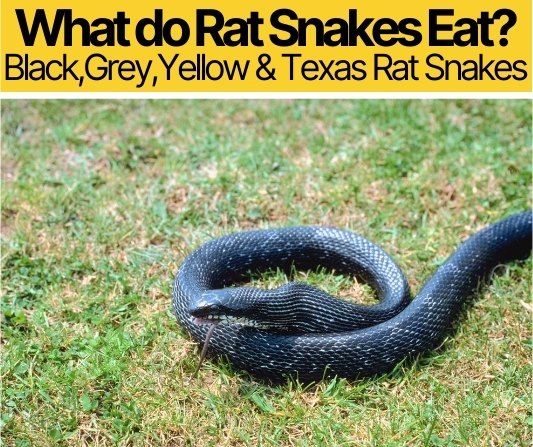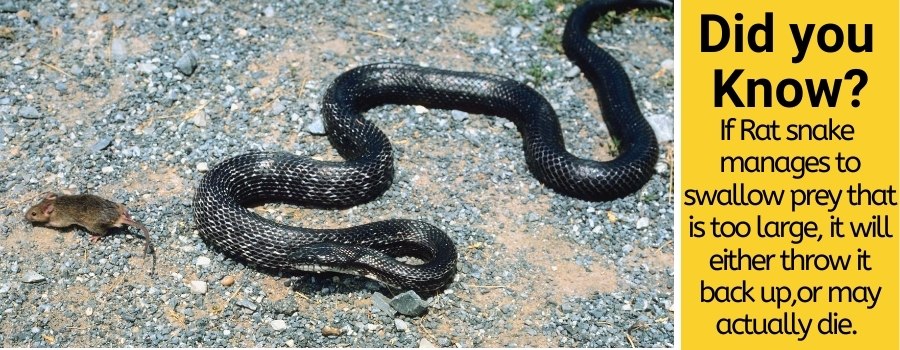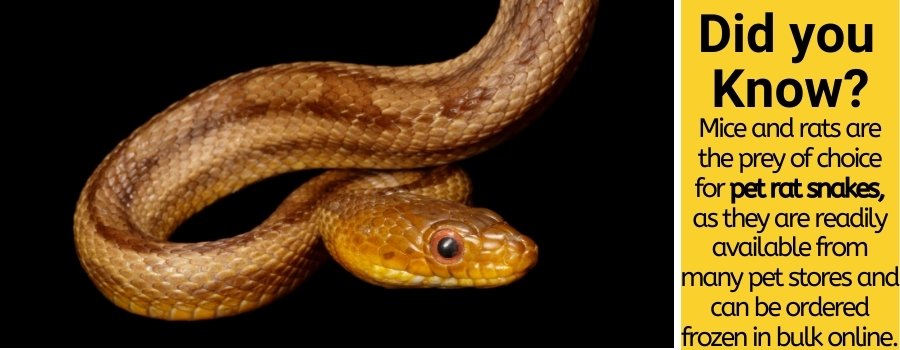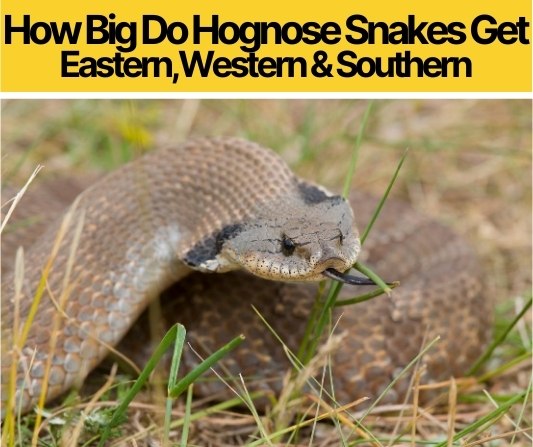 Rat snakes are one of the largest snake species found in North America and their diet varies according to their sub-species and captive or wild status.
Rat snakes are one of the largest snake species found in North America and their diet varies according to their sub-species and captive or wild status.
In this article, we will cover everything about Rat Snakes Diet, What do they eat in the wild and other stuff you should know.
So if you are curious to see what they eat or what can you feed your pet rat snake, keep reading to find out more.
What Do Rat Snakes Eat?
While Rat snakes will eat almost anything that is small enough to catch, rat snakes mainly feed on rodents, amphibians, fish, birds, eggs and other small mammals; and do have a food preference according to their sub-species and location.
These non-venomous snakes are carnivores. Rat snakes kill their prey by constriction, meaning they coil around their chosen meal and squeeze them to death so they can swallow them whole afterwards; they do this thanks to their ligament-connected mandible that allows them to rotate and open wider than any other animal. Snakes do not require chewing because they have a powerful acid in their stomach, which will help break down the food.

Let’s Explore the Most common animals/critters & Items a Rat Snake might eat.
Do Rat Snakes Eat Mouse
As their name suggests, rat snakes feed on all sorts of rodents, starting with mice, rats, moles and hamsters.
Rat snakes are known to be the best rodent predator, being a wonderful way to keep those rodents numbers down, especially those who have become quite a pest problem in farms. A medium-sized rat snake can eat up to 9 pounds of rodents per year (that’s around 200 mice!)
Both captive and wild rat snakes consume all types of mice. However, the major difference is that pet snakes should always be fed frozen mice. On a side note, hatchlings prefer baby mouse or pinkies (for pet reptiles).
Do Rat Snakes Eat Chickens
Wild black, grey, yellow and Texas rat snakes are commonly found living amongst barns, and while they are most likely out for rodents, people call them chicken snakes; but this nickname is actually given because they usually hang around chicken coops searching for chicken eggs- which they love to eat. However, since rat snakes are opportunistic hunters, they will not hesitate in eating the young chicks if available.
As for hens and cocks, adult snakes will not be capable of swallowing a whole big chicken, but that does not mean they won’t try to kill them.
Do Rat Snakes Eat Chicken Eggs
Most snakes have a fascination with chicken eggs and rat snakes will not think twice before using their climbing abilities to reach the nesting box. While all rat snake species do this, the Texas rat snake is known to have a special fondness for freshly laid eggs.
Snakes will reach the nest and quickly swallow the whole egg without breaking the shell; eventually the chemicals in their stomach will break it down.
Do Rat Snakes Eat Birds
Rat snakes are partly arboreal, which means they spend a lot of time climbing trees in search of whichever food they can find, bird nests being one of their favorites.
Birds are one of the Yellow rat snakes preferred meals, and their excellent climbing skills can help them reach even the highest nests, being able to climb up to 60 ft.
These meal options will be more frequent from May to July, when the nesting period for most bird species occurs. Rat snakes prefer attacking nests with young birds in them, rather than those with incubated eggs. According to a research made by the University of Illinois College of Agricultural, these cunning snakes identify which nests have newborns by monitoring the parental activity and patterns of which birds fly back and forth to the same place.
Do Rat Snakes Eat Ducks
Ducks are relatively large for snakes to prey on, but Texas, yellow, and black rat snakes do like to prey on their eggs and ducklings, especially wood duck eggs. Just like with birds, this food source is mostly available from late spring to summer, as incubation and hatching happens.
Do Rat Snakes Eat Squirrels
Wild rat snakes hunt for small mammals, which make squirrels and chipmunks the perfect meal, as a matter of a fact; adult snakes can effortlessly swallow a whole mature grey squirrel.
Their dominant predators would be the black and yellow rat snakes, which can climb trees and brick walls to catch them. Rat Snakes are most likely to bite their heads or tails and coil around their bodies until they suffocate them, causing immediate death.
Do Rat Snakes Eat Frogs
Small frogs are amongst the favorite dishes of young rat snakes. Snake’s swimming and climbing abilities allow them to catch all sorts of frogs and toads in trees, swamps, lakes or buildings.
The yellow rat snake is famous for her fondness for the Cuban tree frog, a green-grayish kind of frog that is considered an invasive pest in Florida.
Do Rat Snakes Eat Rabbits
Unlike other snake species such as python or rattlesnakes, rabbits are not the prime food source of rat snakes, but if they will definitely prey on any small and easy warm-blooded creature, including rabbits.
While a full-grown rabbit can be a little too much for a rat snake, these reptiles do have a tendency to prey on young warm-blooded creatures, so if they find an accessible way to reach for newborn bunnies, they will eat them.
Do Rat Snakes Eat Lizards
As hatchlings prefer cold-blooded creatures, lizards make the perfect meal for those young snakes in training. As snakes get older, they tend to catch larger prey and leave the small ones for the younger snakes.
Lizards are also one of the most common foods for captive and pet snakes; however, they can be highly parasitized so just keep in mind to shop for the best options.
Do Rat Snakes Eat Insects
Unlike the Gartner or green snake, rat snakes are not insectivorous and prefer vertebrate prey. However, some juvenile Texas and black rat snakes do include soft-bodied insects to their usual diets, such as moths, beetles, caterpillars, spiders and crickets.
Remember that wild snakes adapt easily to whatever food they might find depending on their location, weather and availability, so some of them even resource to eating fish or even bats.
Do Rat Snakes Eat Venomous Snakes
No, actually it is the other way around. These noble snakes can be other snake’s food, like for the Indigo snake. In fact, rat snakes are so noble they hibernate and befriend other snake species such as copperheads and rattlesnakes.
Rat snakes are mostly timid creatures that avoid conflict and other predators, like some venomous snakes. But if they feel threatened, these reptiles will lay flat on the ground imitating a fallen branch (known as kink position), imitate the rattlesnakes tail movement and release a powerful musky smell to drive predators away.
How Often do Rat Snakes Eat?
Rat snakes eat once a week or every two weeks, but their voracious appetite will make them eat more than once in a complete day. After killing their prey, rat snakes cover with their meal’s scent, making their presence less noticeable for their next victim. They are so eager to go find their next hunt that sometimes they will leave their victims unfinished.
However, they are one of the three snake species that can survive long periods of starvation. Ball pythons, rat snakes and diamondback rattlesnakes lower their metabolism rate up to 70% in order to survive weeks, months and even years without any food at all.
Pet Rat snakes, hatchlings and young snakes have a faster metabolism, so they require to be fed every four to five days, while adults only require food once a week. A good tip to measure the size of your pet’s meal is to never exceed the diameter of their leaf-shaped head.
What do Rat Snakes Eat in the Wild
Rat snakes are extraordinary swimmers, climbers and even borrowers; so wild snakes’ hunting skills cover basically all types of territories and prey, from animals hiding in tall trees to underground creatures.
Around 50 different sub-species of rat snakes are known, and even though they share a ton of similarities amongst them, each one possesses unique traits that determine their physical appearance, behavior and preferred diet. Let’s see what most common ones found in North and Central America eat.
What do Black ( Eastern) Rat Snakes Eat?
Hatchlings have a black and grey diamond pattern that fades into shiny black scales with adulthood with a light-colored belly. These snakes are the largest amongst the other rat snakes and can be up to two meters long.
Black Rat snakes, also known as Eastern or pilot snakes, prefer to live in high-altitude regions such as sea levels and mountains, preferably on rocky areas and farmlands, but we can also find them in suburban areas. They are most frequent in Eastern and Central USA, from Wisconsin to Missouri, around South Carolina, Kansas, Oklahoma and even South Ontario, in Canada.
Their diets are mostly based on mammals like rats, mice, rabbits, and chipmunks, but they will also eat soft-bodied insects, frogs, lizards, and birds. Apparently, black rat snakes are famous predators for wood duck eggs and squirrels.
What do Grey Rat Snakes Eat?
These reptiles are pretty much the southern brown-greyish version of black rat snakes — they also undergo a white oak phase where they turn completely white. Unlike their black cousins, they do maintain their diamond or squared light blotches even as full adults.
Grey Rat snakes prefer woodlands and grasslands habitats, being most common around Easter and South United States, specifically New Mexico, Indiana, Florida, Wisconsin, Mississippi and even all the way to South Ontario.
Local People call them “chicken snakes” because of their attraction to eggs and chickens, even if they also feed on mice, bats, rabbits, other birds and lizards.
What do Yellow Rat Snakes Eat?
Yellow Rat snakes have a black tongue and a skin color that varies from North to South. Northern species have a greener color; central ones go from olive to orange; and the southern species are bright yellow. Hatchlings are dark-colored, but their skin tones also get lighter depending on their location. Apparently, geo-location also affects behavioral traits, such as aggressiveness.
These species favor tall trees, abandoned houses and farms, preferably close to water resources. They are the type of snake that prefers to live by the coast, so you can find them from North and South Carolina and all over Florida.
Yellow rat snakes are nocturnal creatures, which means they hunt from dusk to night, and they are arboreal creatures. In fact, Florida’s snakes are best known to have an affinity for the Cuban Tree Frog, which lives high up in tall trees, but they will also go for squirrels, chicks, eggs, ducks and rats.
What do Texas Rat Snakes Eat?
Texas rat snakes are the only rat snake specie with a solid grey head and red speckles underneath their scales, but their color varies on where they live. From yellow, olive, and brown to black and albino alterations. In central Texas these snakes show brighter scales, while those on the east are darker.
It’s no surprise that we can find them in central Texas, particularly Dallas, but we can also spot them in Arkansas, Oklahoma and Louisiana. Their habitats go from woods and valleys to cities and farmlands.
Texas rat snakes are most likely to be found in plain daylight searching for food. Even if they feed on small mammals, they are known for preferring fresh-laid eggs and a variety of birds, from wild to domestic. Young chicks and baby birds that have not fledged are their favorites because they are less likely to escape.
What do Red Rat Snakes Eat?
These beautiful reptiles have orange-red scales contoured in black, and can be identified by a blotch in their head shaped like a V. These rat snakes are the friendliest and most docile from all the other species.
This rat snake lives in rocky hillsides, forests and some urban cities. Most commonly found east in USA, from New Jersey to Kentucky, but mostly abundant throughout Florida.
They are excellent climbers, but they spend most of the time underground in burrows where they snatch many rodents. In fact, they are known as corn snakes because farmers used to want them around so they would eat the rats and mice that fed on corncribs. They also eat for eating birds, frogs and fish or anything they can find in their burrows.
What do Baby Rat Snakes Eat?
A month after being born, hatchlings (baby snakes) will start eating, and they will tend to go for smaller prey such as small lizards, frogs and baby mice. Actually, younger snakes prefer cold-blooded prey, while full-grown adults like warm-blooded creatures better.

What do you Feed a Pet Rat Snake?
The first thing to remember is that captive and pet rat snakes behave differently than wild rat snakes. While wild snakes are not used to having people around them feeding them, they have a wild hunter nature and will eat based on whatever they find; on the contrary, pet snakes that are used to being provided with dead prey already do not use their natural hunting skills and are used to a tight feeding schedule.
It is recommended to never feed pet snakes live prey. It is not only more humane, but it is also safer for the snake; since they are not used to haunting anymore, live prey can injure your snake before they even get to it eat.
The ideal meal is to feed them frozen and defrosted mice usually bought on a pet store. These mice can be furless, white or brown, but the important part is that they are 100% free from parasites and other harmful factors.
Some pet owners also provide eggs, rats and lizards to their rat snakes. Just make sure that your vet or a pet store also provides them.
Even as pets, snakes need natural environment stimulation, so it is always advised to warm their food a little before giving it to them.
Related Questions:
Are Rat Snakes Good to have Around? – While these non-venomous and passive creatures make good pets, wild rat snakes can always react differently according to the situation they are facing. If you are looking for a rat snake pet, it is always recommended to get them at a certified breeder or a pet store. Given their nature it is always best to leave wild snakes alone, but do not worry or try to harm them, they represent to harm to humans.
Do Rat Snakes Bites Hurt– Yes, even if they are not venomous, the bigger the snake, the more painful the biting will hurt and they can inflict wounds. Rat snakes do not usually bite unless they feel threatened, they are most likely to just freeze and “rattle” their tails as a signal not to approach them.
Where does the Rat Snake Live? – Different Rat snakes species can be found in North and South America, Africa, Australia and some parts in Asia. The most common species live throughout USA, mainly from Arizona to Florida and all the way to Canada and Mexico.
Are Black rat Snakes Aggressive? – No. While some rat snakes might be more aggressive than others, black ones are amongst the most docile species; but their behaviour can be altered if they feel cornered.


